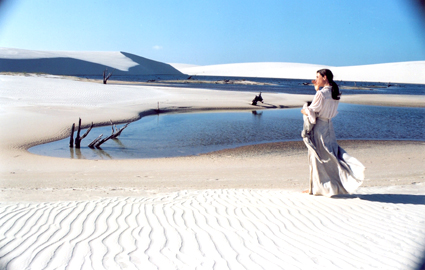|
|
|
|
Directed by: Anrucha Waddington.
Produced by: Leonardo Monteiro de Barros, Pedro Buarque de Hollanda, Pedro Guimarães & Waddington.
Written by: Elena Soárez, based on a story by Luiz Carlos Barreto, Soárez & Waddington.
Director of Photography: Ricardo Della Rosa.
Edited by: Sérgio Mekler.
Music by: Carolo Bartolini & João Barone.
Released by: Sony Pictures Classics.
Language: Portuguese with English subtitles.
Country of Origin: Brazil. 115 min. Rated: R.
With: Fernanda Montenegro, Fernanda Torres, Ruy Guerra, Seu Jorge, Luiz Melodia, Enrique Diaz, Stenio Garcia & Emiliano Queiroz.
After a long dry spell, House of Sand is an original and exceptional
revision of the woman’s picture (in the broad sense and without the melodrama that label often implies). Unlike films that have
substituted a female lead within a typically male genre (Geena Davis’ killing machine in The Long Kiss Goodnight or
Meryl Streep going muscular in The River Wild), this intimate epic is built around the psychology of three generations of
women in a story that never feels imposed upon the characters. (Another good example of a contemporary reworking of the woman’s film
is the Catherine Deneuve vehicle Place Vendôme.)
Wearing what once was their finest Edwardian finery, Áurea (Fernanda Torres) and her mother are stranded in the remote northern desert of Brazil after
having trudged along for more than a month, without water, to occupy the land Áurea’s new and volatile husband has bought. (The
lagoons that were supposed to be part of the acquisition are nothing more than shallow ponds.) After his accidental death and
their servants flee, the two women cannot yet return to their home in the capital – Áurea is already visibly pregnant.
Coming to their aid, offering fish and salt, is Massu (Seu Jorge), a descendent of fugitive slaves. But little will Áurea know how
much she will really be at his mercy.
The engrossing story effortlessly shifts from one era to another. Real-life mother and daughter Fernanda Montenegro and
Fernanda Torres subtly and clearly define their multiple characters: besides Áurea’s mother, Montenegro will play the older
and resigned Áurea (circa 1940), and in the epilogue set in the late ‘60s, Maria, Áurea’s defiant daughter. One flash of
resentment from Áurea (here played by Torres) directed towards her mother succinctly conveys a whole backstory for the once wealthy
woman forced into a marriage of convenience to an odious older man. If the casting is a conceit, it’s a conceit that cleverly works.
The fourth major character is the relentlessly changing landscape. The harsh scenery’s monotony underscores how little changes in
the women’s lives. Unlike other films dominated by landscape (the African segment of Antonioni’s The Passenger comes to mind),
the women are more often than not in the foreground, rather than being stately framed within the overwhelming environment. Director Andrucha Waddington’s camera moves with his characters, turning his film more into a Cast Away-type of adventure rather than an art house meditation. The poetic visual surround, not bury, Áurea and her family.
Kent Turner
August 11, 2006


